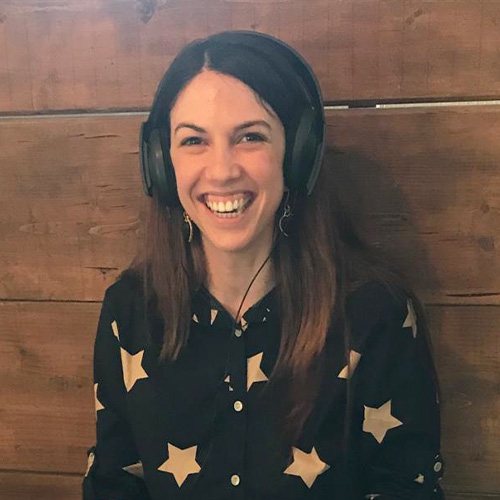

The Corner between Via Saffi and Via Giordano Bruno
The Corner between Via Saffi and Via Giordano Bruno
Riproduci traccia audio
Play audio track
Audio-Track abspielen
The Corner between Via Saffi and Via Giordano Bruno
Trascrizione traccia audio
From this corner of Cesenatico my gaze embraces a piece of history of the city, and a little bit of mine too.
When I look at the town hall, a white, imposing building designed by Giò Ponti in 1960 and situated on the other side of the port, I think it was my father who conveyed to me the love for this town.
For me, as a child, it was the place where I would wait, when my father, after picking me up from school, said to me: “Wait for me here, I have to go up to the office for a moment”. It was always longer than a moment and I would sit in the inner courtyard, fed up with waiting but at the same time proud of my father’s work for the community of Cesenatico.
As a young girl, however, his long absences weighed heavily on me, the time taken away from the family for municipal commitments, those weekends, and parties without him …
It wasn’t until I grew up that I understood his political passion and began to share it.
This side of the canal contains other memories and other stories.
The light green building in front of you, now the local Registry Office, was the first middle school in Cesenatico. It overlooks Piazza Pisacane, which everyone, here in Cesenatico, calls Piazza Garibaldi. I, on the other hand, call it Piazza Arfelli.
This name will not mean much to you, as it didn’t to me until 2021, when we celebrated the centenary of this writer, who with his stories helped me to rediscover my town.
For a few years Dante Arfelli lived in an apartment along one of the arcades overlooking this square and it was right here, in 1949, that he wrote his successful novel, “The Superfluous”. I believe that he sold 800,000 copies through Hemingway’s publisher in the USA!
Arfelli was born in Bertinoro, in the nearby hills, to a peasant family, and at the age of 14 he moved to Cesenatico, the village of his friend Marino Moretti and where there used to be swimming competitions in the water along the port. Here the writer lived his most carefree and profitable years as well as the years when he suffered the most during his brief experience as a soldier in Montenegro.
After the war, when he returned home, Arfelli found a city devastated by the conflict. He realized that Cesenatico lacked a middle school; he decided to change this by founding the school as well as being the headmaster and teacher for the first three years.
Amongst the students, who were enthusiastic about having an easily accessible school in their municipality, was my grandfather Piero; he came from Bagnarola, a rural village inland, with a friend, together every day on the same bicycle. My grandfather was one of the very few of his generation to finish the eighth grade and complete his education. It was from him that my father inherited a strong civic feeling.
Life moved on and a little later there are even more stories to be told: the middle school founded by Dante Arfelli was the school where my mother taught. It was from her that, ever since I was a small child, I inherited the passion for this work, and now in turn I teach in the same school, even if today the school is in a new and much larger site, it still retains the writer’s name.
These stories are like my own roundabout, the places that you now embrace with your eyes are inseparable from my life and that of my family. Places of waiting; places of civil commitment; places of transit, affection, study, writing; places that form the new citizens of Cesenatico.
Dante Arfelli has been gone for many years, but his stories still hover in the air of the town. His memory is like a rare, light, an elusive butterfly, unknown to the most. A butterfly in the streets of Cesenatico.
Audio Track transcription
From this corner of Cesenatico my gaze embraces a piece of history of the city, and a little bit of mine too.
When I look at the town hall, a white, imposing building designed by Giò Ponti in 1960 and situated on the other side of the port, I think it was my father who conveyed to me the love for this town.
For me, as a child, it was the place where I would wait, when my father, after picking me up from school, said to me: “Wait for me here, I have to go up to the office for a moment”. It was always longer than a moment and I would sit in the inner courtyard, fed up with waiting but at the same time proud of my father’s work for the community of Cesenatico.
As a young girl, however, his long absences weighed heavily on me, the time taken away from the family for municipal commitments, those weekends, and parties without him …
It wasn’t until I grew up that I understood his political passion and began to share it.
This side of the canal contains other memories and other stories.
The light green building in front of you, now the local Registry Office, was the first middle school in Cesenatico. It overlooks Piazza Pisacane, which everyone, here in Cesenatico, calls Piazza Garibaldi. I, on the other hand, call it Piazza Arfelli.
This name will not mean much to you, as it didn’t to me until 2021, when we celebrated the centenary of this writer, who with his stories helped me to rediscover my town.
For a few years Dante Arfelli lived in an apartment along one of the arcades overlooking this square and it was right here, in 1949, that he wrote his successful novel, “The Superfluous”. I believe that he sold 800,000 copies through Hemingway’s publisher in the USA!
Arfelli was born in Bertinoro, in the nearby hills, to a peasant family, and at the age of 14 he moved to Cesenatico, the village of his friend Marino Moretti and where there used to be swimming competitions in the water along the port. Here the writer lived his most carefree and profitable years as well as the years when he suffered the most during his brief experience as a soldier in Montenegro.
After the war, when he returned home, Arfelli found a city devastated by the conflict. He realized that Cesenatico lacked a middle school; he decided to change this by founding the school as well as being the headmaster and teacher for the first three years.
Amongst the students, who were enthusiastic about having an easily accessible school in their municipality, was my grandfather Piero; he came from Bagnarola, a rural village inland, with a friend, together every day on the same bicycle. My grandfather was one of the very few of his generation to finish the eighth grade and complete his education. It was from him that my father inherited a strong civic feeling.
Life moved on and a little later there are even more stories to be told: the middle school founded by Dante Arfelli was the school where my mother taught. It was from her that, ever since I was a small child, I inherited the passion for this work, and now in turn I teach in the same school, even if today the school is in a new and much larger site, it still retains the writer’s name.
These stories are like my own roundabout, the places that you now embrace with your eyes are inseparable from my life and that of my family. Places of waiting; places of civil commitment; places of transit, affection, study, writing; places that form the new citizens of Cesenatico.
Dante Arfelli has been gone for many years, but his stories still hover in the air of the town. His memory is like a rare, light, an elusive butterfly, unknown to the most. A butterfly in the streets of Cesenatico.
Audiotrack-Text
From this corner of Cesenatico my gaze embraces a piece of history of the city, and a little bit of mine too.
When I look at the town hall, a white, imposing building designed by Giò Ponti in 1960 and situated on the other side of the port, I think it was my father who conveyed to me the love for this town.
For me, as a child, it was the place where I would wait, when my father, after picking me up from school, said to me: “Wait for me here, I have to go up to the office for a moment”. It was always longer than a moment and I would sit in the inner courtyard, fed up with waiting but at the same time proud of my father’s work for the community of Cesenatico.
As a young girl, however, his long absences weighed heavily on me, the time taken away from the family for municipal commitments, those weekends, and parties without him …
It wasn’t until I grew up that I understood his political passion and began to share it.
This side of the canal contains other memories and other stories.
The light green building in front of you, now the local Registry Office, was the first middle school in Cesenatico. It overlooks Piazza Pisacane, which everyone, here in Cesenatico, calls Piazza Garibaldi. I, on the other hand, call it Piazza Arfelli.
This name will not mean much to you, as it didn’t to me until 2021, when we celebrated the centenary of this writer, who with his stories helped me to rediscover my town.
For a few years Dante Arfelli lived in an apartment along one of the arcades overlooking this square and it was right here, in 1949, that he wrote his successful novel, “The Superfluous”. I believe that he sold 800,000 copies through Hemingway’s publisher in the USA!
Arfelli was born in Bertinoro, in the nearby hills, to a peasant family, and at the age of 14 he moved to Cesenatico, the village of his friend Marino Moretti and where there used to be swimming competitions in the water along the port. Here the writer lived his most carefree and profitable years as well as the years when he suffered the most during his brief experience as a soldier in Montenegro.
After the war, when he returned home, Arfelli found a city devastated by the conflict. He realized that Cesenatico lacked a middle school; he decided to change this by founding the school as well as being the headmaster and teacher for the first three years.
Amongst the students, who were enthusiastic about having an easily accessible school in their municipality, was my grandfather Piero; he came from Bagnarola, a rural village inland, with a friend, together every day on the same bicycle. My grandfather was one of the very few of his generation to finish the eighth grade and complete his education. It was from him that my father inherited a strong civic feeling.
Life moved on and a little later there are even more stories to be told: the middle school founded by Dante Arfelli was the school where my mother taught. It was from her that, ever since I was a small child, I inherited the passion for this work, and now in turn I teach in the same school, even if today the school is in a new and much larger site, it still retains the writer’s name.
These stories are like my own roundabout, the places that you now embrace with your eyes are inseparable from my life and that of my family. Places of waiting; places of civil commitment; places of transit, affection, study, writing; places that form the new citizens of Cesenatico.
Dante Arfelli has been gone for many years, but his stories still hover in the air of the town. His memory is like a rare, light, an elusive butterfly, unknown to the most. A butterfly in the streets of Cesenatico.
Narrato da
Narrated by
Mehr Infos



